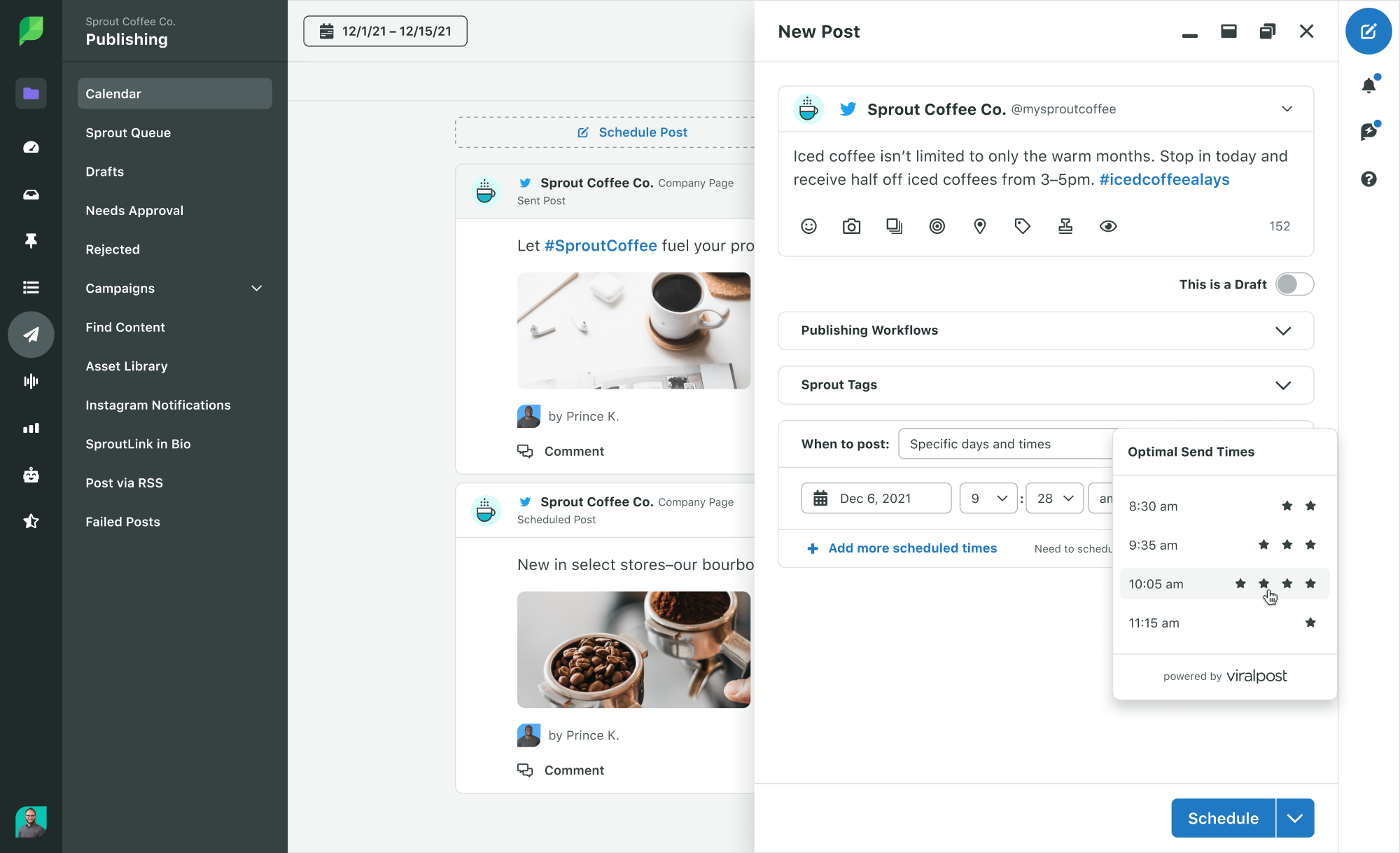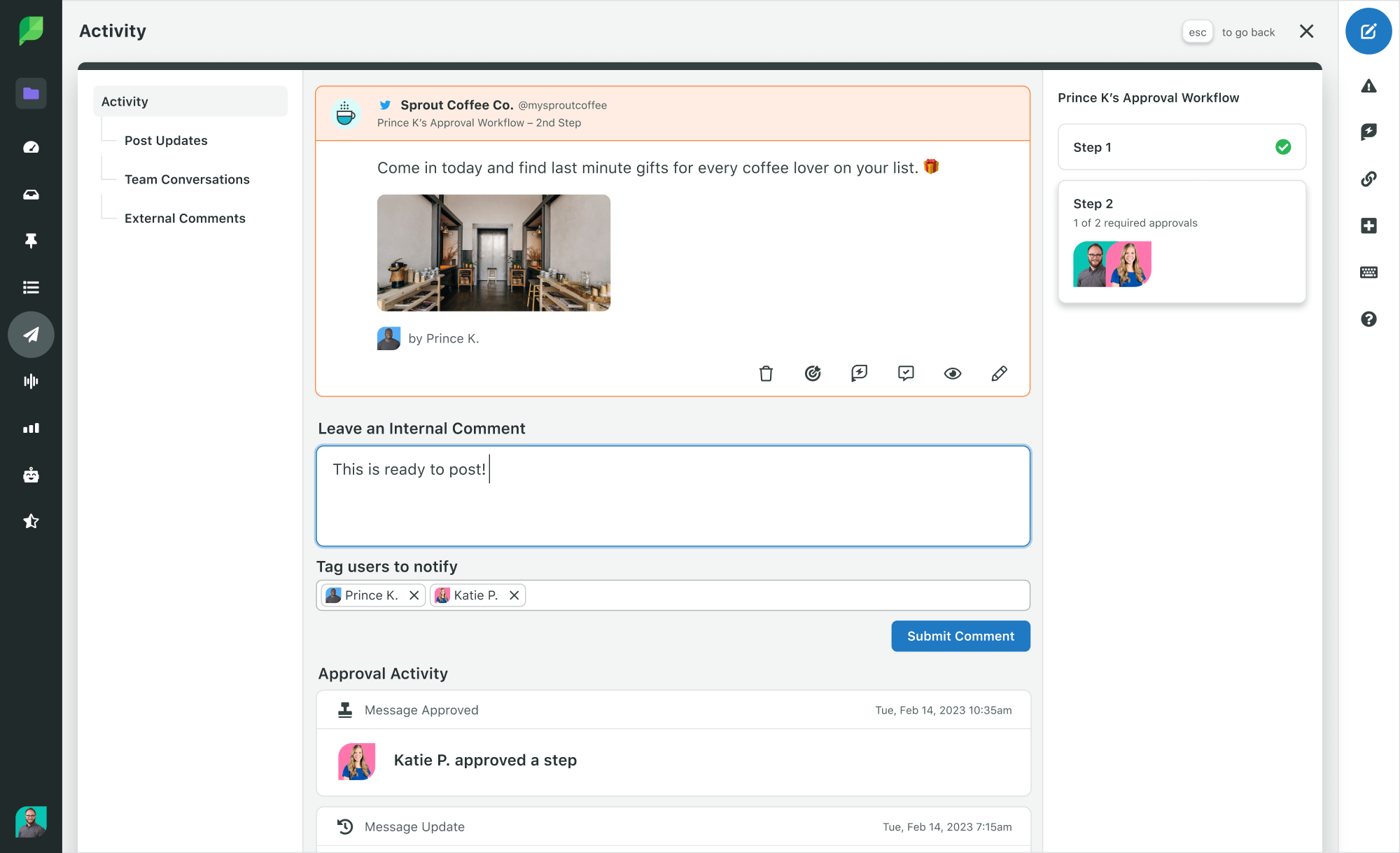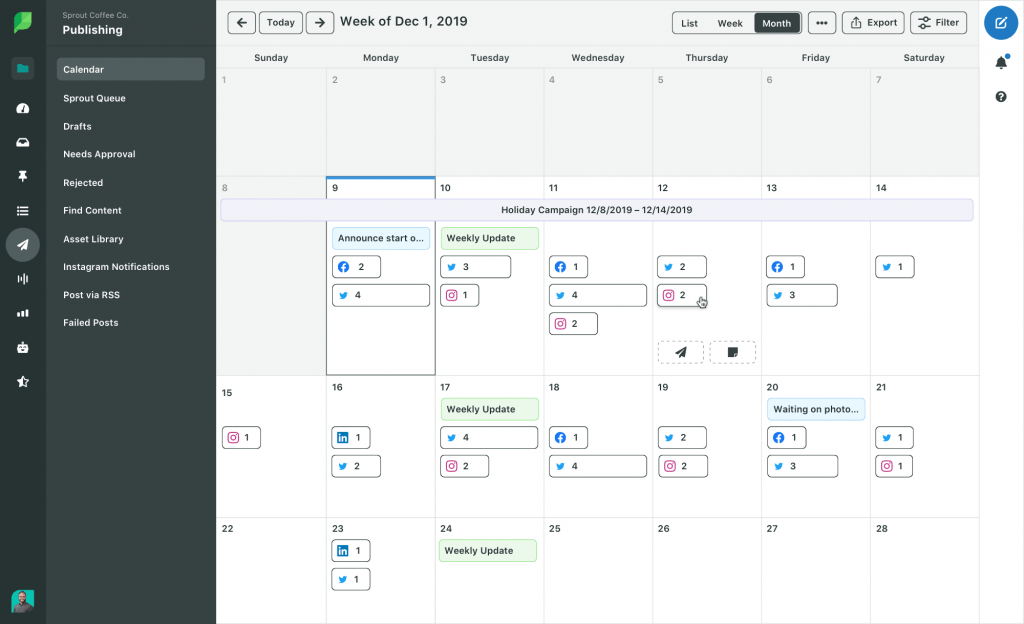Social media campaigns are focused and coordinated efforts that generate measurable results across social media platforms. Campaigns are a chance to switch things up, reach your audience in a new way, create memorable content and make a real impact on top-line business goals.
However, for all the value they can bring, campaigns come with innate challenges. Raise your hand if you’ve ever tried to juggle:
- Concepting, creating and scheduling dozens of social media posts across multiple networks
- Managing your community and monitoring social for all campaign mentions and engagement opportunities
- Soliciting and curating user-generated content
- Reporting on your campaign’s performance to your boss, client or other marketers
- Optimizing your campaign to make sure your numbers keep growing
Whether you’re a brand marketer running multiple campaigns or an agency marketer managing multiple clients, an easy-to-use, turnkey solution that facilitates collaboration, execution and reporting all in one place can work wonders. We’ve created this guide to show you how to run your smoothest, most successful campaign yet—using Sprout Social.
Set your campaign up for success with a comprehensive publishing suite
Once you’ve got your strategy squared away, goals set and creative assets prepped, build your publishing blueprint with Sprout.
Manually logging in and out of native platforms to schedule content can be tedious. Sprout’s intuitive publishing tools help you map out your long-term campaign strategy and schedule content across different profiles and platforms simultaneously. The collaborative calendar is shared with all users in your plan, so marketers, managers, clients and marketing leaders can all view or contribute to your planning efforts
Visually engaging content is an effective way to capture your audience’s attention while delivering information about your brand, product or service. When you’ve invested a lot of time creating beautiful assets to support your campaigns, it’s important to be able to access them with ease as you start scheduling out their content.
Sprout’s Asset Library simplifies asset management, letting you create, organize, edit and publish assets from a central location. This accessibility has become even more important as more people shift to working remotely. Sprout integrates with Dropbox and Google Drive so you can add images or videos to your posts directly from the Compose window. If you feel more secure uploading directly from your computer, you can also easily drag and drop files into the Asset Library.

Social platforms have adjusted their algorithms over the years to serve up more relevant content to users and prioritize paid content. As a result, 45% of consumers now rely on suggestions in their feed and/or use discovery tools to find new accounts to like and follow, compared only 25% using hashtags for the same purpose. While campaign hashtags are still an effective way to encourage engagement among your audience and create a thread of connected content on social, brands also need to embrace other tactics to get eyes on their content.
Including strategic CTAs that drive action and publishing your content at the right time are both crucial to driving authentic engagement and optimizing campaign outcomes. Sprout Social’s patented ViralPost® technology analyzes your audience data to find the times most likely to reach your largest audience and receive real-time engagement updates. Use Optimal Send Times in Compose to schedule with precision and choose the best times to post that are specifically calculated for that profile on that day. Or, configure your Sprout Queue with ViralPost®, an automated approach that schedules your content for you while still optimizing your post times.

Marketers continue to struggle to measure the ever-elusive ROI of social campaigns, but Sprout’s tagging toolset can help. As you compose your content, incorporate a tagging structure that organizes and tracks the success of your marketing campaigns. Each tag should serve a specific purpose. Consider creating tags based on content themes, content types or your goals: for example, awareness, engagement, lead generation and more.
Telfer School of Management at the University of Ottawa has developed a sophisticated tagging tree that the team uses to categorize every post. The upfront work they put into tagging pays off because they’re able to generate a report tailored for any given campaign or stakeholder, which ultimately fosters more transparent and rewarding relationships.
As you run your campaign, you can also use the tags you’ve created to evaluate and test your content and continue optimizing your campaign. In our recent Sprout Sessions Digital event, speakers shared a number of ideas for how customers have used tags to test in the past.
In addition to message tagging, Sprout users can add URL tracking to links to easily identify social referral traffic and conversions from social campaign posts in Google Analytics. Being intentional about your tagging and URL tracking will help later when it comes time to report your results.
Bring leaders and stakeholders into campaign planning with ease
While a specific campaign may be your main point of focus, your content calendar most likely includes plenty of other posts that are part of your overall social strategy. Remember those tags we talked about? Brands can filter their scheduled content by tag and temporarily hide any posts that don’t relate to their campaign from view. This can be helpful if you’re sharing your calendar with leadership or agency clients who want to focus specifically on upcoming campaign posts and strategy.
Since social campaigns ladder up to larger marketing initiatives, brands often implement an approval process that safeguards brand standards. Sprout’s approval workflows let stakeholders review, comment and give final sign off on scheduled posts. This level of governance ensures that marketing leaders feel informed and confident about how social supports campaign goals.

Optimize campaigns with real-time data and feedback
Social campaigns aren’t something you can just set and forget. Consistent management maximizes impact.
While SMMs won’t need to do a full-blown report on their campaign every day, they should be keeping an eye on performance. If you notice a post performing well right out the gate, you can apply those insights to your future content and potentially enhance your campaign in real-time. Additionally, if a Facebook post is resonating with your audience particularly well, or one of your more essential posts is garnering low impressions, you have the option to boost those posts directly in Sprout. A little paid jolt can make a big difference for your campaign.
Inbound messages can also help you revamp content in real-time. The Sprout Smart Inbox centralizes messages from your audience, providing opportunities to engage with new customers and gauge the reaction to your campaign. To organize your inbox, apply message tags as they come in to categorize and separate campaign feedback, leads and customer support.

Sprout’s Inbox Rules allow Advanced Plan users to create automated systems that categorize and apply tags of your choice to specific inbound messages that meet certain criteria. From there, you can surface specific Inbox Views that show only messages relevant to that topic. For example, create inboxes specific to your campaign, customer service issues, product feedback and more. Based on the rules you establish, you can then set up Automated Alerts to receive notifications about the messages you deem most important.
Inbox Rules came in handy for Indiana University when the school encountered a crisis. The social team created rules to auto-apply tags on the specific incoming messages related to the issue and the university.
“Being able to automate that process so that all of the messages that come in during these situations are channeled into one space lets us analyze messages quickly, make decisions or offer suggestions to leadership about what actions should be taken,” says Norman.
Marketers and consumers agree that engagement with audiences is the number one differentiator that makes a brand’s social best in class.
While a lot of inbound messages may relate to customer service issues, there are many other reasons consumers reach out on social. In the latest Sprout Social Index™, we found that 59% of consumers message a brand on social media when they’ve had a great experience.
If someone’s loving your campaign, don’t ignore it. It’s just as important to respond and show your appreciation to those consumers as it is to resolve customer complaints. It can go a long way in building customer loyalty, especially if those consumers are continually engaging with you and your content.
 In Sprout, users can view conversation history between your team and contacts. With that context, you can personalize responses and nurture a lasting customer relationship. In the same window, you can add contacts to VIP Lists, which is useful when identifying brand evangelists and potential ambassadors or influencers for your next campaign.
In Sprout, users can view conversation history between your team and contacts. With that context, you can personalize responses and nurture a lasting customer relationship. In the same window, you can add contacts to VIP Lists, which is useful when identifying brand evangelists and potential ambassadors or influencers for your next campaign.
Use social data to inspire confidence in your campaigns
Campaigns are all about the payoff, but only 43% of social marketers use social data to assess campaign performance. There’s a lot to be learned from social data and without it, you can miss out on valuable insights that support top-line goals.
Sprout’s robust analytics and reporting capabilities help you track campaign success and generate reports that inspire confidence, not confusion. If you strategically tagged your campaign content, the Tag Report presents metrics for each tag so you narrow in on metrics like engagements, impressions and clicks.
And if you forgot to tag your messages when you initially scheduled them, don’t worry—you can retroactively apply tags in the Post Performance Report. Rather than apply tags message by message, users with Professional and Advanced plans can tag them in bulk. For instance, if several messages with the campaign hashtag were sent out untagged, use the search feature to bring those posts to the forefront and tag them all at once.
Hone in on the metrics that matter most
If your brand has built a paid strategy for your campaign, your bosses will be especially curious to know how that money was spent. Sprout’s Paid Performance Reports help track performance and inform budget decisions on the fly for Facebook, Instagram, Twitter and LinkedIn campaigns. The reports are digestible and focus on the metrics that clients and executives alike will care about most, like cost per conversion, cost per click, total spend and more.
If you’re on the organic side and working with a media buyer or paid social expert, these reports can also help you share insights and collaborate to improve both the paid and organic efforts of your campaign.
And to bring it all home, don’t just tell your clients and executives how your campaign performed, show them. With Sprout’s Premium Analytics customers can tailor a report specific to their campaign with custom reporting options. In addition to the out-of-the-box reports offered, you can build a report from scratch by adding and arranging data and text widgets in a way that tells a story and clearly demonstrates campaign success. Once you’ve drilled into the data that underscores the value of social, share it with your social team and beyond.
Conclusion
Putting it simply, Sprout takes the pain out of campaigns. Dad jokes aside, Sprout can truly help nurture your campaigns, community and company goals.
Sprout removes the busywork from your process, streamlines content creation and simplifies reporting so you can focus more time on optimizing your campaign, tending to your customers and looking forward to your next project.
Try Sprout Social for free with a 30-day trial. Already a customer and need help getting started with custom reports? Find more in-depth how-tos on creating custom reports here.
